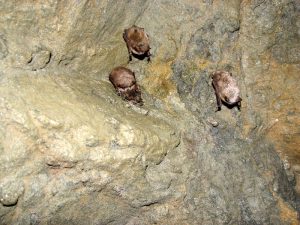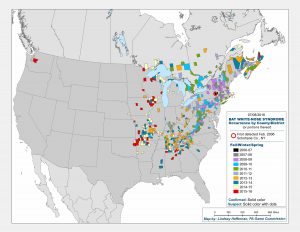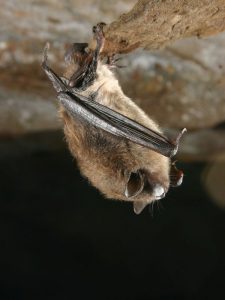In March 2016, two hikers on a trail east of Seattle, WA, found a little brown bat lying on the ground in obviously poor condition. The bat was taken to an animal shelter where it died two days later from White-Nose Syndrome (WNS).
This bat was the first case of WNS found west of the Rocky Mountains. It represented a jump in the spread of WNS, and a troubling one. WNS was first detected in a cave in Albany, New York, and since then it has been moving slowly westward at a rate of about 200 miles per year, according to David Blehert of the United States Geological Survey, the laboratory that confirmed the WNS diagnosis for the Washington bat. Before this year’s discovery outside of Seattle, the westward-most case detected was in eastern Nebraska.
WNS, caused by a cold-loving fungus, Psuedogymnoascus destructans (Pd), can kill 100% of the hibernating bats in a colony, and in the ten years since it has been detected and monitored has killed over 6 million bats in the United States and Canada. As of July 2016, bats infected with the fungus have been found in 29 states and 5 Canadian provinces.
According to Blehert, this is probably the “most significant epizootic of wildlife” ever observed; never before have we seen hibernating mammals specifically affected by a skin fungus. What does that mean? Are we looking at extinction for some bat species? What are the ecological consequences of rapidly losing so many individuals to disease so quickly? And, what, if anything, can be done to combat the disease and help bat populations recover?
Contributions of Bats
Bats are significant contributors to many ecosystems—making up almost one-fifth of all mammalian species on Earth and living in almost every habitat, from cave to desert to riparian forest. They also contribute significantly to our agricultural economy. Guano is the primary nutrient of the cave ecosystem—containing bacteria and other microorganisms—that the other animals of caves depend on for survival.
As pest controllers, bats have huge economic importance to commercial agriculture, and are estimated to save farmers in the U.S. alone 3.7 billion dollars annually by preventing pest damage and reducing pesticide use. In a 2015 study, Maine and Boyles looked at crop protection against the corn earworm provided by bats found that not only did bats protect the crops from pest damage, but the protective effects extended indirectly to suppressing two opportunistic plant pathogenic fungi (Aspergillus flavus and Fusarium graminear) that produce toxic products (alflatoxin and fumonisin), which reduce the value of corn. A different study by Reiskind and Wund from 2009 reported a significant decrease in egg-laying activity of female mosquitos that were subjected to predation by the northern long-eared bat.
Bats that are not insectivores typically eat fruits and nectar, and as such are important seed dispersers and pollinators, particularly for night blooming plants and desert plants like the Agave plant and Seguaro cactus. Fermented juices from the agave plant are used to make tequila and drive a multi-million dollar industry. In the absence of bats, agave propagation is estimated to fall to 1/3,000 of normal.
Bats also can have indirect effects in other ecosystems, for instance a study by Miller and Chernoff from Wesleyan University showed a correlation in increase of fish abundance with decreases in the call abundance of two bat species. They suggest that decreased bat predation of insect species in the river may be responsible for the increase in fish abundance through a “predator release” mechanism. This work is evidence of aquatic-terrestrial linkage in the river ecosystems that they studied.
What we know about WNS and Its Effects

One of the interesting observations of this epizootic is that bats in North America are being killed by this fungus, but bats in Europe and Asia appear to be tolerant to it; infection with the fungus is less severe in Europe and Asia. Scientists working on understanding WNS are attempting to identify any differences among fungus isolated from bats in Asia, Europe and North America and the bat responses to it. The bat species in Asia and Europe tend to be larger, and perhaps that gives them more reserves to use to survive the disease.
Meanwhile, much work has been done to understand progress of the disease in affected bats in North America. Verant et al. published work in 2014 that described WNS as a disease that progresses through multiple stages. Early stage disease involves Pd colonizing the wing of the bat. Once the fungus is established, it damages the epidermis. During this early stage, carbon dioxide levels in the blood also increase, leading to acidosis and increased potassium levels (hyperkalemia).
As the carbon dioxide levels continue to rise, chemoreceptors are triggered that stimulate hyperventilation, causing arousals from torpor in an attempt to remove the excess carbon dioxide. The energy required for these arousals depletes hibernation fat reserves. Additionally the arousals would increase body temperature, causing more evaporative water loss and dehydration of the animal.
As the disease becomes more severe and the damage to the epidermis worse, water loss may increase through the lesions, causing more arousals from hibernation to drink. The increased arousals use more fat stores and energy, feeding back and causing a vicious cycle, leading to death of the animal. Even if the bat survives to emerge in spring, according to Blehert, it may mount an overly vigorous immune response that actually exacerbates the disease.
What’s Next?
So now that we are developing an understanding of the disease physiology and the organism that causes it, what is next in the fight against WNS?
Researchers want to look closely at the individual strains of the fungus that are found in Europe, Asia and North America to see how they are related to each other genetically. Do the North American fungal strains represent some kind of recently emerged super pathogen? Or, are they really similar to the strains found in other areas and the differences lie strictly in the response of the bats?
What can we learn from the environment? If we look at the soil in the caves with and without WNS, is there something about them that either promotes or prevents the development of environmental reservoirs of Pd. Are there naturally occurring microorganisms in cave ecosystems that could provide some protection to bat communities? Is there another fungus that is non-pathogenic that can compete with Pd in the cave ecosystem and prevent it from becoming established in large amounts?
And even, is it possible to develop an oral vaccine that could be given to bats to lessen or prevent the pathology associated with the presence of the fungus?
All of these are ongoing areas of research as we seek to understand and hopefully control this devastating epizootic.
Michele Arduengo
Latest posts by Michele Arduengo (see all)
- An Unexpected Role for RNA Methylation in Mitosis Leads to New Understanding of Neurodevelopmental Disorders - March 27, 2025
- Unlocking the Secrets of ADP-Ribosylation with Arg-C Ultra Protease, a Key Enzyme for Studying Ester-Linked Protein Modifications - November 13, 2024
- Exploring the Respiratory Virus Landscape: Pre-Pandemic Data and Pandemic Preparedness - October 29, 2024


